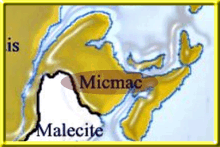
The Maliseet, also known as the Malecite, are a First Nations people native to the northeastern region of North America, primarily in what is now New Brunswick and Quebec, Canada. The Maliseet people have a rich cultural heritage and have lived in the area for thousands of years, long before the arrival of European settlers.
The Maliseet people have a matrilineal social structure and were traditionally hunters, fishermen, and farmers, relying on the rich resources of the St. John River and its tributaries. They were known for their elaborate birch bark canoes and their sophisticated system of trade and exchange, which extended across much of the northeastern region.
In the 1600s and 1700s, the Maliseet people were actively involved in the fur trade, working as intermediaries between European traders and other Indigenous nations. This period also saw the arrival of European diseases, which had a devastating impact on the Maliseet population.
Throughout the centuries, the Maliseet people have faced numerous challenges, including land confiscation, forced relocation, and cultural suppression. Despite these difficulties, the Maliseet people have maintained their cultural traditions and today, there are a number of Maliseet communities across Canada that are working to revitalize their language and culture.
In recent decades, the Maliseet people have been recognized as a distinct First Nations group with their own unique culture, traditions, and history. They continue to play an important role in shaping the cultural landscape of the region and advocating for their rights as Indigenous peoples.
Here is a brief timeline of some of the key dates and events in the history of the Maliseet people:
Pre-contact: The Maliseet people have lived in the northeastern region of North America for thousands of years, long before the arrival of European settlers.
1600s: European contact with the Maliseet people begins with the arrival of French fur traders in the region. The Maliseet people quickly become involved in the fur trade, working as intermediaries between European traders and other Indigenous nations.
1700s: The arrival of European diseases has a devastating impact on the Maliseet population. The Maliseet people also face increasing pressure from European settlers, who are seeking to control the rich resources of the St. John River and its tributaries.
1755: The Maliseet people are forced to abandon their ancestral lands along the St. John River and flee to other parts of the region. This marks the beginning of a long period of land confiscation, forced relocation, and cultural suppression for the Maliseet people.
1825: The first Maliseet reserve is established in Tobique, New Brunswick.
Mid-19th century: The Maliseet people begin to organize politically, forming alliances with other Indigenous nations to advocate for their rights.
1980s: The Maliseet people gain recognition as a distinct First Nations group with their own unique culture, traditions, and history.
Today: There are a number of Maliseet communities across Canada that are working to revitalize their language and culture, and to advocate for their rights as Indigenous peoples. The Maliseet people continue to play an important role in shaping the cultural landscape of the region.
